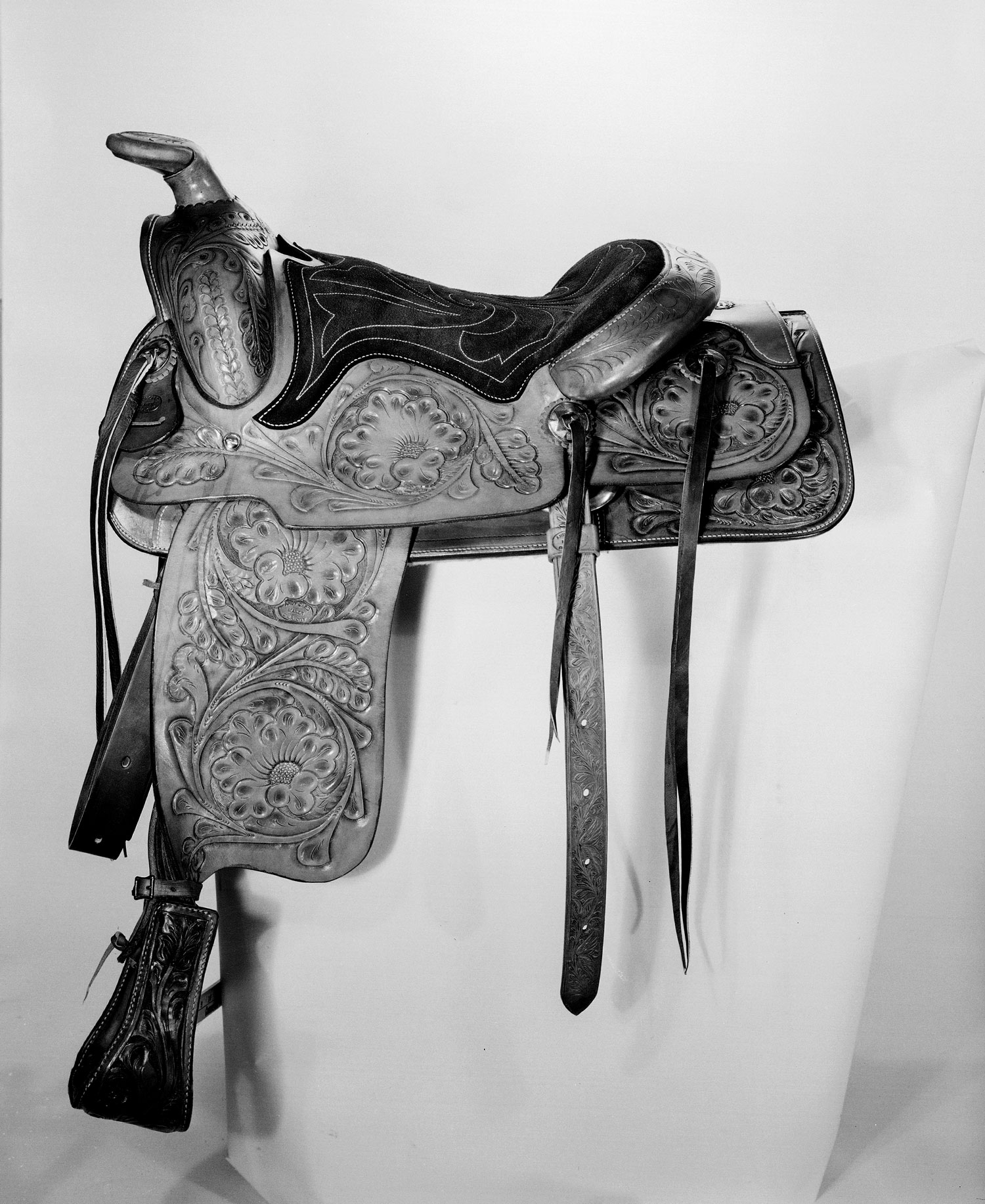
The Encyclopedia of Oklahoma History and Culture
BOOT AND SADDLE MAKERS.
The Western stock saddle and the cowboy boot are specific material culture items associated with the ranching industry that developed in the trans-Mississippi West during the nineteenth century. The Western saddle, with its distinctive design of high cantle, large swell, and horn for attaching a rope, developed in Texas during the 1840s and 1850s. The tall cowboy boot, with its characteristic high underslung heel and pointed toe, reputed to have developed in Kansas during the 1860s and 1870s, is the cattlemen's modification of the high-topped, low-heeled, and square-toed Civil War cavalry boot to make it more efficient while working from horseback. By the time non-Indian settlement began in earnest Oklahoma during the late 1880s both the cowboy boot and the western stock saddle were in general use in the region.
Within a few years after Oklahoma's 1907 statehood saddle making began to concentrate in the Oklahoma City Stockyards area with firms such as Hughes, Bozarth, & Anderson (1911–47), Stockyards Saddlery (1925–present), and National Saddlery (1941–present), as well as several independent makers. There were many other saddle makers scattered across the state but no real concentration comparable to that in the capital city. At the beginning of its settlement every town of any size had a combination harness and saddle shop producing a custom-made product. This changed by the 1930s as the use of horse-drawn transportation waned and the demand for harness slowed, but saddle making remained a well-respected craft throughout the state.
In the post–World War II era, with the sport of rodeo enjoying tremendous growth in popularity and Oklahoma's horse industry becoming more and more important, several saddle makers from the state became well known. In the 1970s Lawton's Howard Council redesigned the competitive calf-roping saddle to make it more efficient by putting the roper more forward in the seat. His design has been widely used by makers across the country. John Rule of Oklahoma City developed a reputation for building custom saddles for rodeo competitors, and from 1990 to 1999 he built the World Champion trophy saddles for the Professional Cowboy Rodeo Association. In Tulsa, Charlie Beals at Veach Saddlery (1946–94) and the Mock family of saddle makers (1941–present) have acquired an enviable reputation for their quality work. Others in the state continue to supply custom-made saddles to both professional rodeo performers and the horse-loving public.
Boots, like saddles, were made by boot- and shoe-making craftsmen across Oklahoma from its earliest days. As early as 1894 in the western part of the state Woodward's Joseph Hunter advertised "cow boy boots a specialty" and "cow boy boots of his own make." Boots remained important gear for the ranching community and evolved from the plain, undecorated work boot to a more sophisticated footwear with fancy stitching and inlayed leather of various colors on the uppers.
Although many well-known boot makers have plied their trade in Oklahoma, including Don Atkinson of Pawhuska and Andy Card of Oklahoma City, some of the best were associated with the Blucher Boot Company. C. G. "Gus" Blucher worked at the Justin Boot Company at Spanish Fort, Texas, for twenty years before establishing his company in Cheyenne, Wyoming, in 1915 and later moving to Olathe, Kansas. Blucher pioneered leather inlay design and custom boots by mail order. After his death in 1932 the company moved several times, ultimately settling at Guthrie, Oklahoma. The firm continued a reputation for high-quality workmanship designed for the working cowboy. At the beginning of the twenty-first century the firm is located at Beggs, Oklahoma, and still produces its original, work-oriented patterns.
Custom boot and saddle making was overshadowed in the 1970s when the Urban Cowboy craze swept the country. Demand for western gear became so great that a multitude of factory-made brands of boots, saddles, and other Western-themed items inundated the market. The prices were cheaper than those of custom-made products. Although this phenomenon has largely faded, the western gear market remains much larger than it was before the Urban Cowboy phenomenon, and custom boot and saddle makers successfully continue to ply their trade within the state.
Perhaps the best indicator of this demand is the survival of the shoe, boot, and saddle-making program operating at the Oklahoma State University extension campus at Okmulgee. Begun soon after the end of World War II as a shoe-repair school for returning war veterans, it soon added boot and saddle making to its two-year course of study. At the turn of the twenty-first century it was the nation's only college-accredited program to train boot and saddle makers and maintains an annual enrollment of twenty-five to thirty-five students. Many of its graduates have remained in Oklahoma, applying their skills to keep a traditional craft alive in a highly mechanized modern society.






